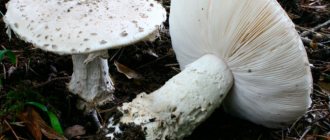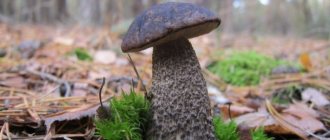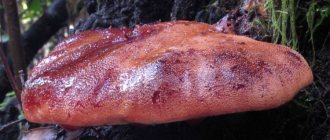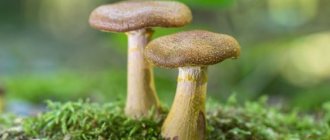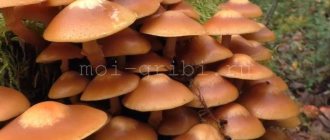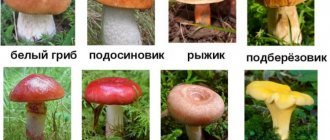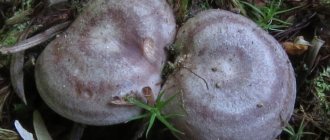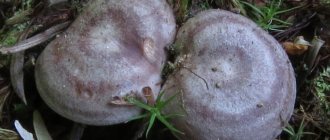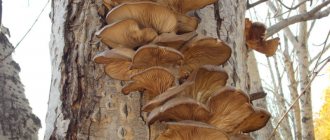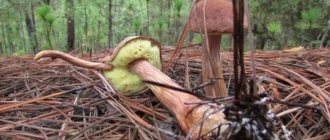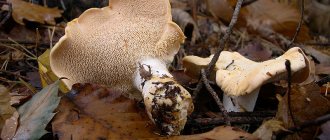The appearance of this representative of the mushroom kingdom will not leave anyone indifferent! The unique and unforgettable appearance of the white fly agaric, combined with its dangerous properties, gives it admiration and caution from mushroom pickers.
White fly agaric
It also has the following names:
- Lemon fly agaric
- Fly agaric yellow-green
- Yellowing grebe
- Death cap
- Spring fly agaric
- Spring grebe
These names were not obtained by him lightly. External characteristics allow us to compare this mushroom with a lemon, yellow-green shades. However, people call it toadstool, due to the poisonous properties in its composition.
You will learn more important information about this representative of the fly agaric genus from the article below. I will give you a complete description of the appearance of this type of mushroom, tell you what toxic substances are in its composition and how they affect the human body.
Detailed description of the mushroom
Description of the white fly agaric
Other porcini mushrooms have a number of serious differences, so you can always distinguish them in the forest and not accidentally put them in your basket. But, in order to distinguish them, you need to know the structural features of the legs and caps of this type of fly agaric.
Features of the appearance and structure of the cap
Thanks to its cap of white shades, the toadstool fly agaric stands out perfectly among the forest landscape. It can grow in both coniferous and deciduous forests.
The diameter of the cap reaches up to twelve centimeters in diameter. The shape of young specimens is convex, the edges of the cap fitting tightly to the stem. As they age, they rise to form an umbrella shape. The convex part in the center of the mushroom also disappears, forming something like a small hole.
Young individuals of the fungus have white shades. The color changes depending on the soil in which the fly agaric grows. A mature mushroom acquires yellowish-green shades. It was thanks to these flowers that it was popularly nicknamed the yellow toadstool.
The surface of the cap may have large flakes of gray and white flowers.
The plates are located under the surface of the cap. They grow tightly not only to the cap, but also to the stem of the mushroom. The color is white, the arrangement is frequent, the thickness is small.
In acidic soils the cap grows yellow with yellow edges. White spore powder is found between the plates. Similar to flour - oval, smooth shape.
Appearance and structure of the leg
The length reaches ten centimeters. Under conditions of highly fertile soil and optimal growth temperatures, the length can reach eighteen centimeters in length. The structure inside is solid, decorated with a skirt exactly in the middle of the leg.
The shape of the skirt is swollen, thin and neat. It fits tightly to the surface.
With aging, the density of the leg decreases and transforms into dust. Typically, this process begins to occur closer to mid-autumn.
The leg of the white fly agaric often becomes a favorite habitat for various worms and insects. Poisonous properties and elements do not negatively affect all these living creatures.
Features of the structure of the flesh of the toadstool
It can be distinguished from all mushrooms similar to this type by its pulp. Newly grown specimens have white flesh that does not darken when cut and in contact with oxygen. As they age, the shades become yellow and the aroma becomes sharp and unpleasant. The taste is also unpleasant. A bad aroma will give it away immediately if it accidentally ends up in your cart.
Precautionary measures
How to protect yourself and your loved ones from poisoning by poisonous mushrooms?
To do this, you should follow a number of simple rules:
- You should only collect familiar types of mushrooms. Any doubt in identifying a mushroom is a good reason not to add it to the basket.
- You cannot store unknown mushrooms in the same basket as edible ones. If you want to show them to a more experienced mushroom picker later, put them in a separate container. You should not touch such mushrooms with your bare hands.
- It is necessary to cut mushrooms with a whole stem - this helps in identifying them.
- You cannot buy dried, salted, pickled and canned mushrooms from random people and in places of spontaneous trade.
- Under no circumstances should you try mushrooms while picking!
If you follow all these precautions, then you don’t have to worry about becoming a victim of a beautiful, but very dangerous destroying angel. https://www.youtube.com/embed/LHGU7148UkQ
Time and place of growth
Where does the white fly agaric grow
? Temperate latitudes of the planet earth are preferable for this mushroom. Basically, the families of these grebes can be found in the middle latitudes of Russia. You can meet small groups of them in Eastern and Western Europe. They are also found in Canada and a number of other European countries.
Coniferous, deciduous, and mixed forests are the main habitat for the growth of the toadstool. When you see one white fly agaric, you know that you will meet many brothers.
The soils on which the mushroom grows are acidic. Vegetation is always poor. The soil, with a high amount of acidic substances, contains all the necessary substances for the growth of this type of fungus.
Oak, pine, spruce and birch are the preferred trees for the formation of mycosis. Also grows in the mountains.
The growth period is from early July until the first frost in November. The mushroom is tenacious and can be found after severe frosts.
When it bears fruit
Often, the main period for the birth of new fruiting bodies in the white fly agaric falls in the first days of June. However, you should also not discount exceptions that could arise due to unstable weather, natural disasters, and the like.
In the case when the summer season is rainy and humid, the fruiting season can last until the end of August. In the case of constant droughts and strong winds, white fly agarics stop bearing fruit in July. In any case, at the beginning of September the poisonous plant completely stops its reproductive function.
Similarities with other species
The toadstool fly agaric is not the only one of its kind. It can be confused not only with edible species of the kingdom, but also with poisonous mushrooms.
Umbrella white
White Umbrella Mushroom
Confused with this mushroom - white umbrella. After consuming the hero of the article, people go to the hospital. Severe poisoning is one of the main symptoms of use. The toadstool and umbrella are very similar.
Similar in these characteristics:
- Flat hat
- White flakes on the surface of the cap
- Diameter that does not exceed twelve centimeters
- Fleshyness, thickness of the oval cap
Differences:
- Leg height. The umbrella is a little lower
- Aroma. The toadstool has a bad smell, the white umbrella, on the contrary, has a pleasant aroma
- Taste. Toadstool is sour and tastes unpleasant. The umbrella has good taste
A sure-fire way to check: cut into any of the prey you find and taste the aroma. The toadstool smells rotten, but the umbrella does not.
The umbrella is safe. Prepared for the table often. It is considered a valuable catch among mushroom pickers. Without experience in distinguishing the two species from each other, do not take them into your catch.
Thin umbrella
Thin umbrella mushroom
The diameter of the cap and stem is their main difference. The edible specimen has a smaller cap.
A thin umbrella can be eaten raw, because... it is part of the champignon family.
Stinky fly agaric
Mushroom stinking fly agaric
Similar in the color of the cap. Both species have white caps. The stinking fly agaric has a volva, which is the main difference.
The stinky doppelgänger has a sharply unpleasant odor, as its name suggests. The mushroom is deadly poisonous and is not recommended for consumption.
Taxonomy
Verne's fly agaric was first mentioned in scientific literature by the French mycologist Jean Boulliard in 1780 in the form of Agaricus bulbosus. Boulliard warned that it could easily be confused with the edible field mushroom (Agaricus campestris), and that for those who ate it, adding vitriol ether to wine or crushed garlic to milk should be used as a remedy. The species name verna comes from the Latin word for "spring". Three years later, Jean-Baptiste Lamarck gave it special species status in his Methodical Encyclopedia, Botany.
The fool's mushroom (Amanita verna), also known as the destroying angel or angel of death, is a close relative of the toadstool (Amanita phalloides), and a member of the genus Amanita mushrooms. The spring grebe, like its close relative, belongs to the subfamily Phalloideae.
Hallucinogenic and poisonous properties
Properties of the white fly agaric
It was recently classified as poisonous. Some lovers of experiments and thrills often eat white fly agaric. This mushroom, like the red fly agaric, also causes colorful hallucinations. Therefore, I cannot advise you to eat it.
Folk craftsmen claim that with proper processing, the mushroom can be fried, stewed and even made into soups! I don’t recommend taking risks; poisoning is still possible.
Psychoactive substances included:
- Solomanidin
- Phalloidin
- Bufotenin
These substances will in any case cause digestive upset.
Hallucinations appear in the eater due to the presence of a large number of alkaloids in the mushroom. In addition to alkaloids, the fly agaric mushroom contains substances that relax the human nervous system. As a result, a person may simply fall asleep, or become very inhibited. The most terrible effect of use is aggression.
Application
Since childhood, many of us, when we mention the fly agaric, have a picture of a bright red thick fly agaric with white dots, driving away flies. But a particularly toxic, smelly mushroom is not suitable for repelling insects - it will poison everything around. The only niche occupied by a particularly dangerous representative of the Amanitaceae family is its use in folk medicine.
For a long time, with the help of mushroom tinctures and decoctions of white fly agaric, human metabolism has been normalized. Recent biochemical studies have shown that the spring toadstool contains a fair amount of the biogenic amine choline, a vitamin-like (vitamin B4) substance with high physiological activity that can influence human metabolism and reduce cholesterol levels. Healers keep the proportions and recipes for making mushroom infusions a big secret.
First aid for poisoning
Help for fly agaric poisoning
When consuming lemon fly agaric, act quickly. The negative effect will come quickly, and the consequences can be fatal.
The first and most important thing is fingers in mouth. You must induce vomiting. The whole mushroom should come out, do not let the gastric juice begin the process of breaking down negative elements. The second first aid remedy, if the first does not help, is to drink as much boda as possible. Drink water and induce vomiting. It is advisable to induce the gag reflex at least twice in order to maximally avoid the negative impact of harmful effects.
Chemical composition
Two groups of particularly toxic substances are contained in mushroom pulp. The first group contains muscarine, serotonin, muscimol, bufotenine, ibotenic acid. These five substances underlie the properties of the red fly agaric, which cause hallucinations when poisoned. The second group is characterized by the content of toxic substances - scopolamine and hyoscyamine, tropane alkaloids, which cause severe intoxication, like henbane. The combination of two severe toxins can be fatal if a person eats more than five poisonous mushrooms.
Deadly white fly agaric, photo and description of symptoms resulting from poisoning with poisonous mushroom food, occurring just an hour after eating it:
- nausea with uncontrollable vomiting;
- persistent diarrhea;
- dryness of all mucous membranes, acquiring a gray tint;
- difficulty breathing and tachycardia;
- rapid increase in body temperature;
- dilated pupils;
- twilight of consciousness;
- excitement alternates with euphoria;
- hallucinations;
- without medical help – death.
